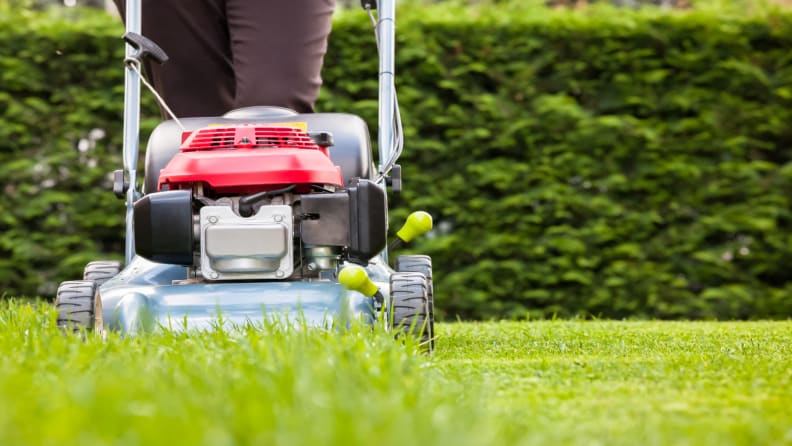Tick season will be bad this year—here's how to protect your yard
Keep your outdoor space as safe as possible from those Lyme-carrying menaces.
 Credit: Getty Images / Choreograph
Credit: Getty Images / Choreograph
Recommendations are independently chosen by Reviewed’s editors. Purchases you make through our links may earn us a commission.
In the summer months, there's no better place to be than right in your own backyard. As wonderful as the warmth is, the downside to lounging outside is that you'll have to share space with various creepy crawlies that love fun in the sun as much as you do. And while we try to let them be, many bugs aren't known to extend the same courtesy to us. Perhaps the most concerning bug coming out to play is the tick—a tiny, parasitic relative of the spider.
蜱虫有广泛的物种和卡尔y many different diseases, but deer ticks (also called blacklegged ticks), which transmit Lyme disease, are of particular concern. States in the Northeast, from Maine to Virginia, are on highest alert, but Lyme disease is present in all 50 states. It’s been recently discovered that blacklegged ticks can also transmit thePowassan virus, which can be fatal. Meanwhile, the Lone Star Tick, which cancause red meat allergies, is found mostly in the southeast. No matter where you live, you’ll want to make your backyard as inhospitable to ticks as possible. Here’s some advice from an expert on how to keep the ticks at bay this summer.
Minimize areas in your yard that might draw ticks

Keeping your grass clipped can help minimize your tick presence.
Ticks favor areas high in grass, brush, and trees, according to the疾病预防控制中心. Uprooting your trees is a surefire way to make your yard less appealing to ticks. But let’s face it, that’s a lot of work for something that will make your home a lot less beautiful. Fortunately, there are other solutions to make your space less tick-friendly.
“Keep grass cut low, especially around fence lines, sheds, and trees,” says Jim Fredericks, Ph.D., chief entomologist for the National Pest Management Association. “Additionally, remove weeds, woodpiles, and other debris that could serve as nesting areas for mice, which can carry ticks into a yard.”
You’ll also want to ensure your garbage cans are sealed and contained—loose waste can attract raccoons, rats, and skunks, which all carry ticks. Finally, check and treat your pets for ticks, as owning a pet doubles your risk, according to a study published inZoonoses and Public Health. Be sure any pets who spend time outdoors are treated with topical or systemic tick-repelling treatments, so they are less likely to bring ticks (and fleas) inside.
Create physical barriers to keep ticks out
The CDC advises placing wood chips or gravel between the lawn and any wooded areas to make the area less attractive to ticks since they tend to not like crossing over dry areas. Additionally, should be kept rimmed near playground equipment.
If possible, you may want to fence in your yard to keep out deer—they’re not called “deer ticks” for nothing.
Guard your skin when you go outside

Heading outside? Make sure to apply bug spray beforehand.
Because ticks are so prevalent in the summer, simply being outside may pose its own tick-based risk. “People spending time outdoors should consider wearing long pants and sleeves, as well as using aninsect repellentcontaining an EPA-registered ingredient like DEET, picaridin, or oil of lemon eucalyptus,” Fredericks says.
One simple trick you can do to ward away ticks is to tuck your pant legs into your socks. This works best if your socks are thick and your pants are thin. This may not keep ticks from you completely, but it can help to keep ticks from coming in contact with your skin.
If your backyard is particularly heavy in brush, you may want to take an extra precautionary step by buying pretreated clothing or clothing sprays containing permethrin, which, according to the疾病预防控制中心, is a chemical that kills ticks, fleas, cockroaches, and mosquitoes, and lasts through several washings.
一个lways double-check your body, just to be safe
Finally, no matter how many preventative measures you’ve taken, you should do a scan of your body after being outside. Use a hand mirror to ensure you see all parts of your body, and if you have kids and/or pets, check them, too. The CDC also advises taking a shower within two hours of coming inside, which has beenshown to reduce the risk of contracting Lyme disease, as it provides a good opportunity to check for ticks and wash off any that haven’t yet attached.
If you do find a tick, the疾病预防控制中心advises using a pair of fine-tipped tweezers to grab the tick as close to the skin as possible. Once you get a good grip, pull with a steady upward motion to ensure no parts of the tick get left behind in your skin. Then, wash your hands and clean the area with rubbing alcohol or soap and water and drown the tick in alcohol, place it a sealed or zipped bag, or flush it down the toilet to dispose of it.
You should also get in touch with your doctor, particularly if you couldn’t fully remove the tick—in those cases, antibiotics may be needed, according to theMayo Clinic. If you can’t go to a doctor right away, take the next few weeks to keep an eye on the area where the tick was, as well as your overall health. If you develop a rash, fever, or flu-like symptoms, make an appointment with your doctor to discuss your situation and treatment options.
The product experts atReviewedhave all your shopping needs covered. Follow Reviewed onFacebook,Twitter,Instagram,TikTok, orFlipboardfor the latest deals, product reviews, and more.
Prices were accurate at the time this article was published but may change over time.





